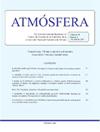积雪对臭氧监测仪甲醛观测的影响
IF 1
4区 地球科学
Q4 METEOROLOGY & ATMOSPHERIC SCIENCES
引用次数: 0
摘要
甲醛(HCHO)是利用背向散射紫外线从太空测量的。由于HCHO的寿命较短,对HCHO的天基观测可以作为挥发性有机化合物的代表,有助于表征其全球排放和分布。HCHO卫星观测依靠空气质量因子(AMF)计算将拟合的斜柱转换为垂直柱密度。大多数HCHO卫星产品在计算amf时没有明确考虑地面积雪的存在。本研究利用MODIS双向反射分布函数(BRDF)、MODIS积雪信息和交互式多传感器冰雪测绘系统的信息,评估了地面积雪对OMI HCHO反演的影响。我们的分析集中在2005年。我们比较了使用每日MODIS BRDF计算的amf与使用OMI的表面反射气候学计算的amf,后者是NASA OMHCHO产品的基线。在积雪覆盖地区,两组amf表现出显著差异。我们观察到两种不同的行为。使用MODIS BRDF计算的永久积雪地区(格陵兰岛和南极洲)的amf比使用OMI气候学计算的amf要小,导致HCHO vcd的年中位数增加6%。在有季节性积雪覆盖的地区,情况更为复杂,年内差异的变异性更大。例如,2005年2月对欧洲的一个案例研究表明,NASA OMHCHO vcd(使用OMI Lambertian气候学计算)平均比使用每日MODIS BRDF信息检索的HCHO列大16%。本文章由计算机程序翻译,如有差异,请以英文原文为准。
The influence of snow cover on Ozone Monitor Instrument formaldehyde
observations
Formaldehyde (HCHO) is measured from space using backscattered ultraviolet
sun-light. Because of HCHO’s short lifetime, space-based observations of HCHO can serve
as a proxy for volatile organic compounds, helping to characterize their global
emissions and distributions. HCHO satellite observations rely on Air Mass Factor (AMF)
calculations to transform fitted slant columns into vertical column densities. Most HCHO
satellite products do not explicitly consider the presence of snow on the ground during
the calculation of AMFs. In this study, we leverage information from the MODIS
bidirectional reflectance distribution function (BRDF), MODIS snow cover information,
and the Interactive Multisensor Snow and Ice Mapping System to evaluate the impact of
ground snow on Ozone Monitoring Instrument (OMI) HCHO retrievals. We focus our analysis
on the year 2005. We compare AMFs computed using daily MODIS BRDF to AMFs computed using
OMI’s surface reflectance climatology, the baseline for NASA’s OMHCHO product. Over
snow-covered regions, both sets of AMFs show significant differences. We observe two
different behaviors. Regions with permanent snow cover (Greenland and Antarctica) show
smaller AMFs calculated with MODIS BRDF than with the OMI climatology resulting in a 6%
median annual increase of HCHO VCDs. Over regions with seasonal snow cover, the
situation is more complex with more variability in the differences during the year. For
example, a February 2005 case study over Europe shows that the NASA OMHCHO VCDs
(calculated using the OMI Lambertian climatology) are on average 16% larger than HCHO
columns retrieved using daily MODIS BRDF information.
求助全文
通过发布文献求助,成功后即可免费获取论文全文。
去求助
来源期刊

Atmosfera
地学-气象与大气科学
CiteScore
2.20
自引率
0.00%
发文量
46
审稿时长
6 months
期刊介绍:
ATMÓSFERA seeks contributions on theoretical, basic, empirical and applied research in all the areas of atmospheric sciences, with emphasis on meteorology, climatology, aeronomy, physics, chemistry, and aerobiology. Interdisciplinary contributions are also accepted; especially those related with oceanography, hydrology, climate variability and change, ecology, forestry, glaciology, agriculture, environmental pollution, and other topics related to economy and society as they are affected by atmospheric hazards.
 求助内容:
求助内容: 应助结果提醒方式:
应助结果提醒方式:


